Photographs by Laurence Cooke, except for the two historic ones, which come from the Library of Congress Prints and Photographs Online Catalog. Many thanks to both. The interior photographs are reproduced here by courtesy of the Dean and Chapter of Lincoln Cathedral. Text by Jacqueline Banerjee, 2017. You may use the images of the exterior without prior permission for any scholarly or educational purpose as long as you (1) credit the photographer or source and (2) link your document to this URL in a web document or cite the Victorian Web in a print one. Click on the images to enlarge them.

Lincoln Cathedral, southwest aspect. Photochrom print, c.1890-1906. Library of Congress reproduction no. LC-DIG-ppmsca-52397.
The Cathedral Church of St Mary, Lincoln, better known as Lincoln Cathedral. This Grade I listed building has a long history stretching back to the foundation of the original place of worship in the eleventh century, followed by rebuilding (its history has been dogged by fire, earthquake and strong winds), remodelling, extensions and additions. It is of dressed stone ashlar with lead roofs, and encompasses various styles: "Romanesque, Early English, Perpendicular and Tudor Revival" (listing text). Its plan is complex and includes a chapter house, school, libraries and cloisters. Victorians such as Viollet-le-Duc and George Gilbert Scott found it particularly fascinating because, according to Edmund Venables (1819–1895), who had been the Precentor of the Cathedral, "the choir and eastern transept of Lincoln" provided "the earliest dated example of pure Gothic architecture, without any lingering trace of Transitional feeling; the first perfect development of what is known as the Early English style" (qtd. in Kendrick 17).


Other views of the exterior: Left: North end of the Great Transept with the "Dean's Eye" rose window, and cloisters below. Right: Closer view of part of central tower and transept.
Seen above are examples of thirteenth- and very early fourteenth-century work: the transepts were extended and completed in c. 1230-1235; the crossing tower was rebuilt in c. 1240; and the cloisters were added in c. 1290-1300. Then the crossing was heightened in 1307-11 (all dates from the listing text). It is amazing that so many phases of building, by different hands, contribute to the noble appearance and general impact of the building that we see now.
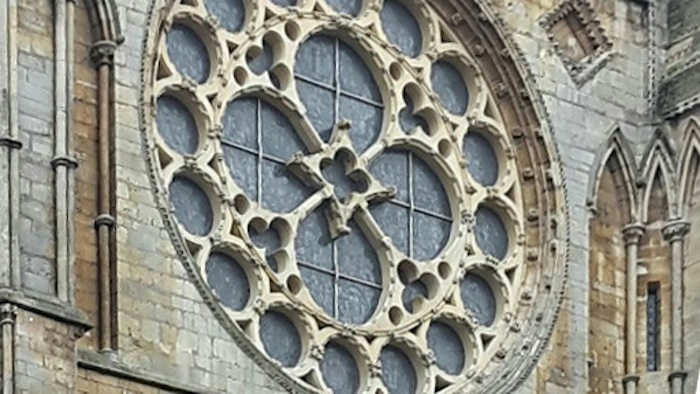
Close-up of the rose window in the gable of the northern end of the transept.
According to the listing text, "North and south gables [of the Great Transept] have outstanding traceried round windows, C13 and early C14." While this one is called the "Dean's Eye," the one at the south end is called the "Bishop's Eye." The theme of the "Dean's Eye" is the Last Judgement, and some of the original glass remains: it has recently been triumphantly restored. But, as can be imagined, there is always more restoration going on here: see "Restoration Projects."
Interior

Lincoln Cathedral, looking east through the choir to the sanctuary. Photochrom print, c.1890-1906. Library of Congress reproduction no. LC-DIG-ppmsca-52398.
The magnificent choir is called after St Hugh of Lincoln, who, as Bishop Hugh of Avalon, directed the first phase of reconstruction after the earthquake of 1185. The extension of the choir has another special name: the Angel Choir, because of the carvings of angels in the spandrels of the arches.
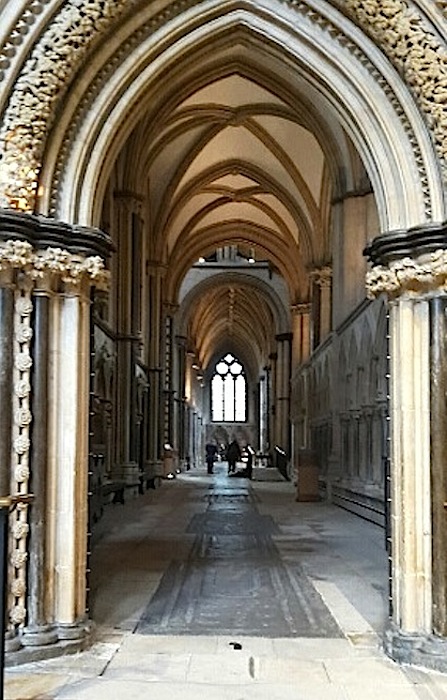
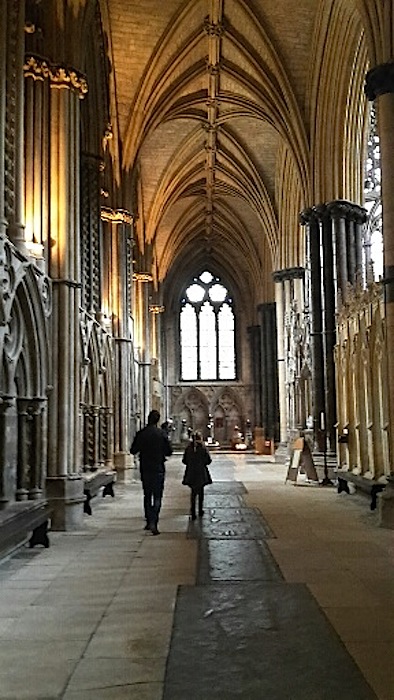


Left to right: (a) Intricately carved aisle doorway, north of St Hugh's Choir. (b) Walking down the aisle. (c) Looking up at the beautiful ribbing of the vault. (d) The south end of the Great Transept, with the "Bishop's Eye" window.
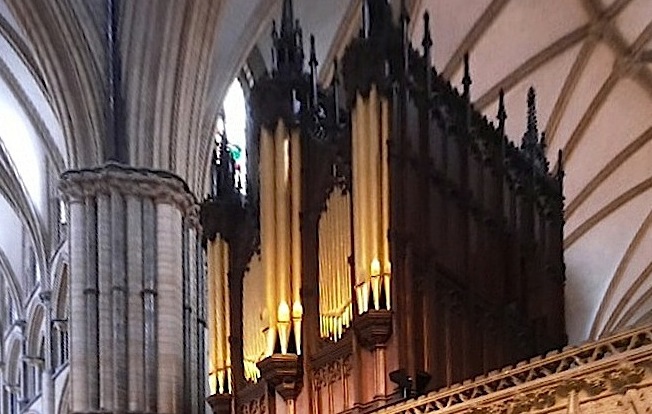
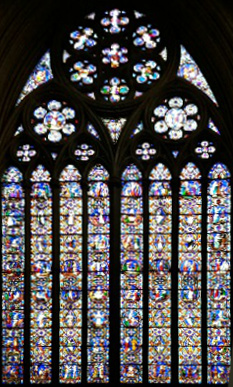

Left to right: (a) Pipework from the original Father Willis organ. (b) The Great East Window. (c) Detail of the window, showing Jesus on a donkey in the middle — a Palm Sunday scene.
The original Father Willis organ was completed in 1898: "it proved to be the last cathedral organ finished by 'Father' Willis himself, and one of his finest instruments. It also has the distinction of being one of two Willis organs in English cathedrals to retain its original tonal scheme" ("Father Willis Organ"). Despite later changes, it has kept its original pipework.
As for the stained glass, the east window and windows in the north aisle are by the London firm of Ward and Hughes: it is, of course, no coincidence that Thomas Ward's brother was Dean of Lincoln Cathedral from 1845 to 1860. The magnificent east window was installed in 1855, and cost £2,000 even then. Writing at the very end of the Victorian period, the historian of the cathedral, A. F. Kendrick claimed that
The great east window is considered to be the finest example of its style in the kingdom. It is of eight lights, "formed by doubling the four-light," and has a great circle in the head, filled with a six-foil surrounded by half-a-dozen quatrefoils. "Bar-tracery being fully developed," we read in a note to Rickman's Gothic Architecture, "the general appearance of the window is rather Decorated than Early English, but the mouldings still belong to the earlier style. This window ... together with the whole of that part of the choir is singularly and beautifully accommodated to the style of the rest of the building." [122]
The Victorians are often criticised for their insensitive restoration of these ancient places of worship, while their valuable contributions to them tend to be passed over. Here, the canopied pulpit of 1863, designed by Scott, has been found wanting (see Kendrick 108); but the organ and east window are widely acknowledged to be fine examples of Victorian work in the Cathedral.
Related Material
Bibliography
"Cathedral Church of St Mary and Cloisters and Chapter House and Libraries." British Listed Buildings. Web. 1 November 2017.
Cheshire, Jim. Glass and the Victorian Gothic Revival. Manchester: Manchester University Press, 2004.
"Father Willis Organ." Lincoln Cathedral. Web. 1 November 2017.
Kendrick, Albert Frank. The Cathedral Church of Lincoln. 1898. Corrected ed. London: G. Bell & Sons, 1902. Internet Archive. Contributed by the University of Toronto. Web. 1 November 2017.
"Restoration Projects." Lincoln Cathedral. Web. 1 November 2017.
"Ward and Hughes: Stained Glass Manufacturers." Wood Green Parish (a useful source of information on the firm). Web. 17 November 2017.
Last modified 25 November 2017